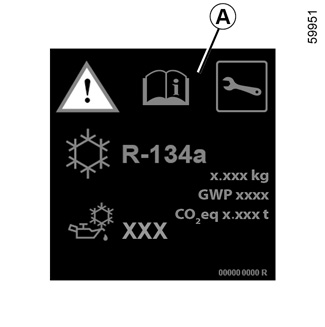AIR CONDITIONING: information and operating instructions
Advice on use
In some situations (air conditioning off, air recirculation activated, ventilation speed at zero or low etc.), you may notice that condensation starts to form on the windows and windscreen.
If there is condensation, use the “Clear View” function to remove it, then use the air conditioning in automatic mode to stop it forming again.
Fuel consumption
You will normally notice an increase in fuel consumption (especially in town) when the air conditioning is operating.
For vehicles fitted with air conditioning with no automatic mode, switch off the system when it is not required.
Advice for reducing consumption and helping to preserve the environment
Drive with the air vents open and the windows closed. If the vehicle has been parked in the sun, open the doors for a few moments to let the hot air escape before starting the engine.
Maintenance
Refer to the Maintenance Document for your vehicle for the inspection frequency.
Operating faults
As a general rule, contact your approved dealer in the event of an operating fault.
- Reduction in de-icing, demisting or air conditioning performance.
This may be caused by the passenger compartment filter cartridge becoming clogged.
- No cold air is being produced.
Check that the controls are set correctly and that the fuses are sound. Otherwise, switch off the system.
Presence of water under the vehicle
After prolonged use of the air conditioning system, it is normal for water to be present under the vehicle. This is caused by condensation.
Do not add anything to the vehicle’s ventilation circuit (for example, to remove bad odours).
There is a risk of damage or of fire.
Use the air conditioning system regularly, even in cold weather, running it at least once a month for approximately 5 minutes.
Do not open the refrigerant fluid circuit. The fluid may damage eyes or skin.


The refrigerant fluid circuit (of which some components are hermetically sealed) may contain fluorinated greenhouse gases.
Refrigerant fluid R-134a
Depending on the vehicle, you will find the following information on label A affixed inside the engine compartment.
The presence and location of the information on label A depends on the vehicle.
Ñ Type of refrigerant fluid
(XXX) Type of oil in the air conditioning circuit
Consult the driver’s handbook
Maintenance
Quantity of refrigerant fluid present in the vehicle. | ||
x.xxx kg
| ||
Global Warming Potential (CO2 equivalent). | ||
GWP xxxx
| ||
Quantity in weight and in CO2 equivalent. | ||
CO2 eq x.xxx t
| ||
Do not open the refrigerant circuit. The fluid may damage eyes or skin.
Before carrying out any action in the engine compartment, you must switch off the ignition STARTING, STOPPING THE ENGINE: vehicle with key or STARTING, STOPPING THE ENGINE: vehicle with card.


Refrigerant fluid R-1234yf
Depending on the vehicle, you will find the following information on label B affixed inside the engine compartment.
The presence and location of the information on label B depends on the vehicle.
Ñ Type of refrigerant fluid
(XXX) Type of oil in the air conditioning circuit
Inflammable product
Consult the driver’s handbook
Maintenance
Quantity of refrigerant fluid present in the vehicle. | ||
x.xxx kg
| ||
Global Warming Potential (CO2 equivalent). | ||
GWP xxxx
| ||
Quantity in weight and in CO2 equivalent. | ||
CO2 eq x.xxx t
| ||
